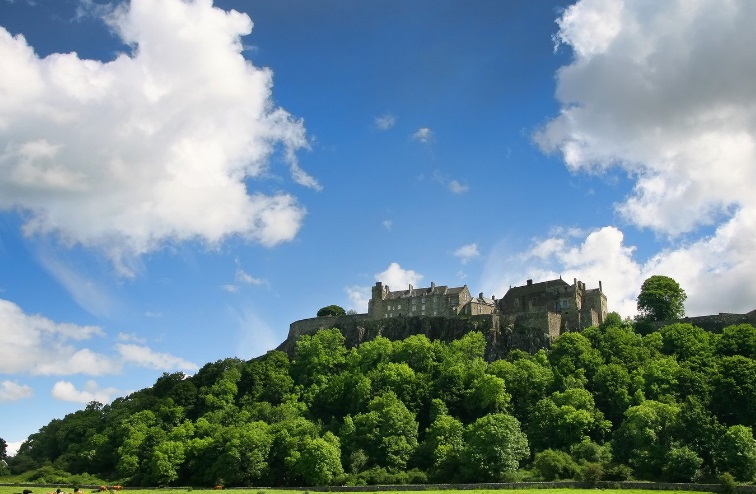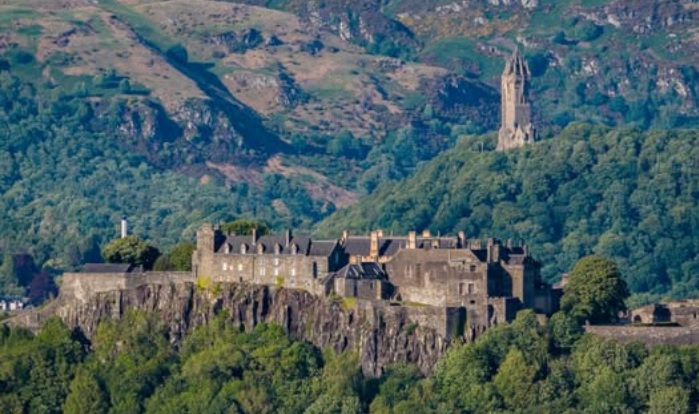Stirling Castle
Stirling Castle: A Symbol of Scottish Power and Heritage
Stirling Castle, perched dramatically atop Castle Hill in central Scotland, is one of the country’s most significant historical and architectural landmarks. With roots stretching back to the early Middle Ages, the castle has served as a royal residence, military fortress, and strategic stronghold for centuries. Its location near the River Forth made it a vital gateway between the Highlands and Lowlands, which contributed to its prominence in Scotland’s history.
A Strategic Location
Stirling Castle’s position was of immense strategic importance. Controlling the crossing point of the River Forth meant controlling access to much of Scotland. This made the castle a focal point in both political and military terms. It saw many sieges and battles, especially during the Wars of Scottish Independence in the late 13th and early 14th centuries. The nearby Battle of Stirling Bridge in 1297, where William Wallace and Andrew Moray defeated English forces, underscored the area’s military value.
Throughout these turbulent years, Stirling Castle changed hands multiple times between the Scots and the English. It wasn’t until Robert the Bruce’s decisive victory at the Battle of Bannockburn in 1314—just a short distance from the castle—that the fortress remained securely under Scottish control for a longer period.
Royal Residence and Renaissance Glory
While the early history of Stirling Castle is steeped in warfare, it also served as a key royal residence. Several Scottish kings and queens were crowned at Stirling, including Mary, Queen of Scots, who was crowned there in 1543 when she was just nine months old. The castle’s role as a royal palace reached its zenith during the reigns of James IV, James V, and James VI.
These monarchs transformed Stirling into a Renaissance palace. James IV initiated major construction projects, including the Great Hall, completed around 1503. This hall is the largest of its kind ever built in Scotland and served as the venue for feasts, ceremonies, and royal events. James V added the Royal Palace, richly decorated with sculptures and tapestries. Its blend of French Renaissance and Scottish architecture reflected the cultural ambitions of the Stewart monarchy.
One of the most distinctive features of Stirling Castle is the Stirling Heads, a collection of intricately carved oak medallions that adorned the ceilings of the palace. These heads depict monarchs, nobles, classical figures, and biblical characters, showcasing the artistry and sophistication of the period. Many were restored or recreated during recent conservation efforts.

Military Importance and Decline
By the 17th century, Stirling Castle’s importance as a royal residence began to decline, particularly after the union of the English and Scottish crowns in 1603 under James VI and I. With the monarchy now based in London, Stirling evolved more into a military garrison and stronghold.
During the Jacobite uprisings in the 18th century, Stirling Castle was once again in the spotlight. In 1746, Bonnie Prince Charlie’s forces unsuccessfully laid siege to it. Although it remained in government hands, this period marked the end of its direct involvement in major military conflict.
The castle continued to serve as a military base well into the 20th century. It housed soldiers and officers, including the Argyll and Sutherland Highlanders regiment, whose presence is still commemorated at the Regimental Museum located within the castle grounds.
Restoration and Tourism
Today, Stirling Castle is managed by Historic Environment Scotland and is a major tourist attraction. Extensive restoration work has returned many parts of the castle to their 16th-century appearance, particularly the Royal Palace. Costumed interpreters, interactive exhibits, and recreated royal apartments allow visitors to experience the splendor of the Renaissance court.
The castle’s panoramic views across the Scottish countryside, including to the Wallace Monument and the Ochil Hills, enhance its appeal. Its significance as a national symbol of Scottish identity, resilience, and culture ensures its place in both academic history and popular heritage.
Conclusion
Stirling Castle stands not only as an architectural gem but also as a living chronicle of Scotland’s tumultuous and inspiring history. From royal coronations to bloody battles, from Renaissance grandeur to military strategy, the castle has played a central role in shaping the nation. Today, it remains a place where the past comes vividly to life, reminding visitors of the enduring legacy of Scotland’s storied past.

